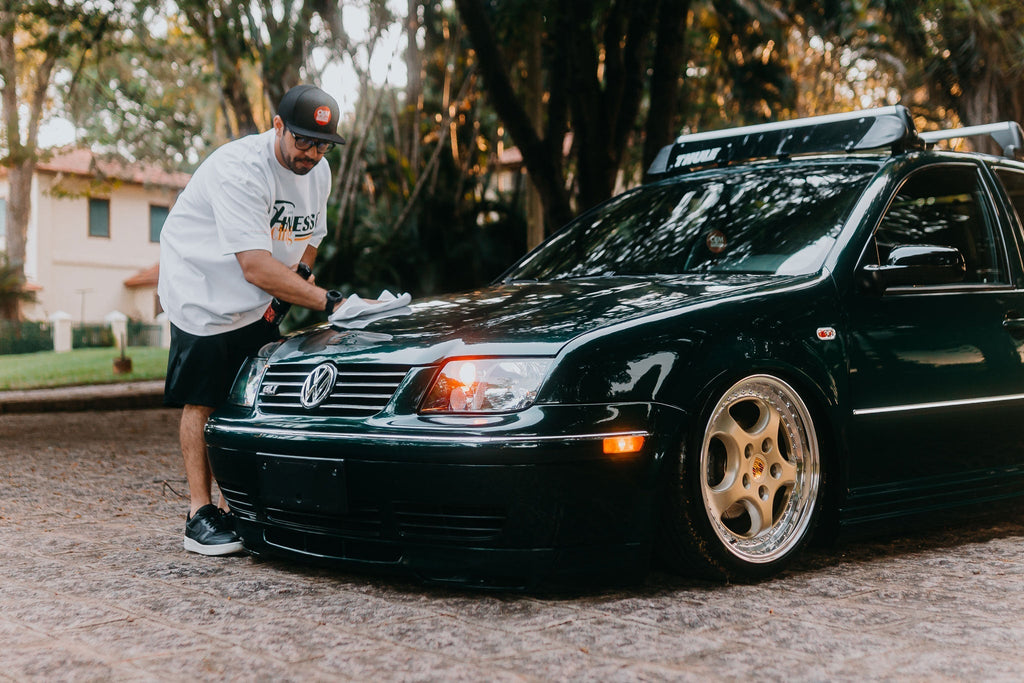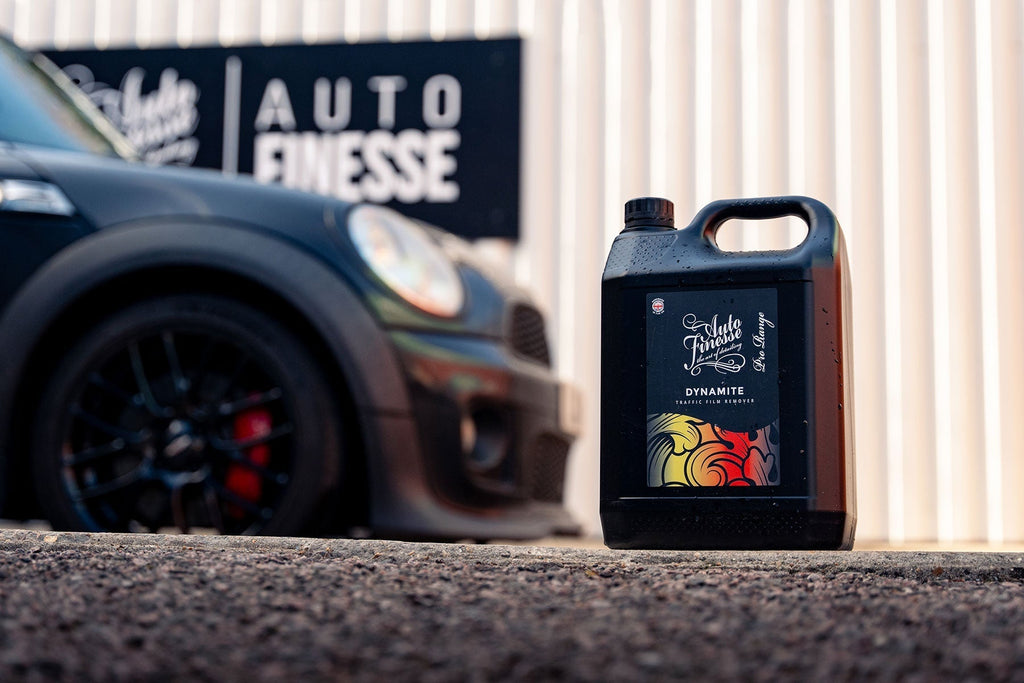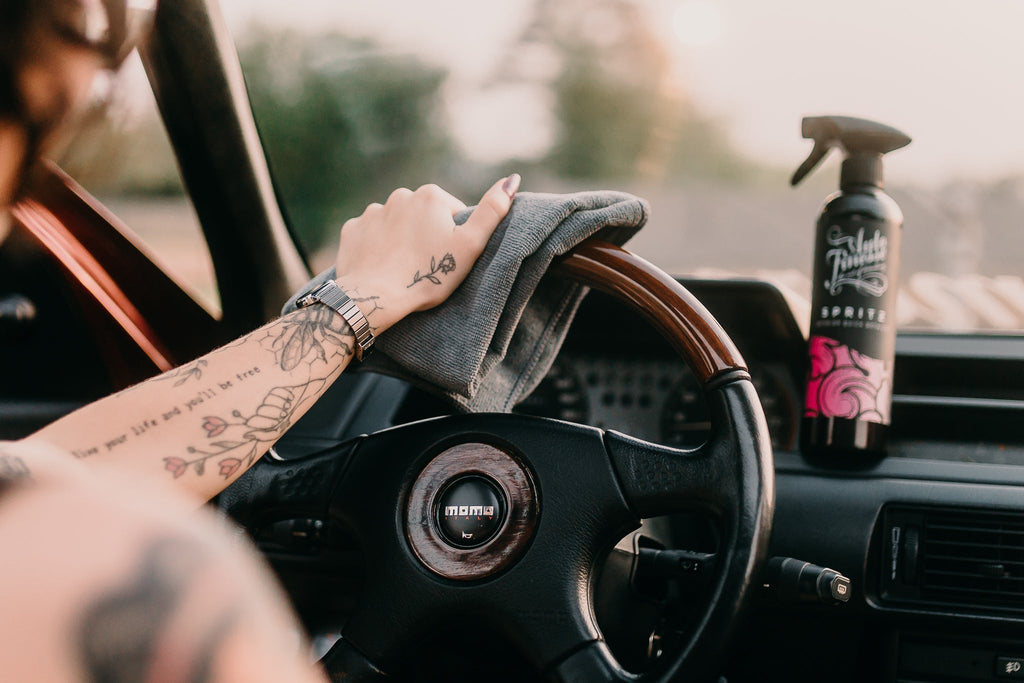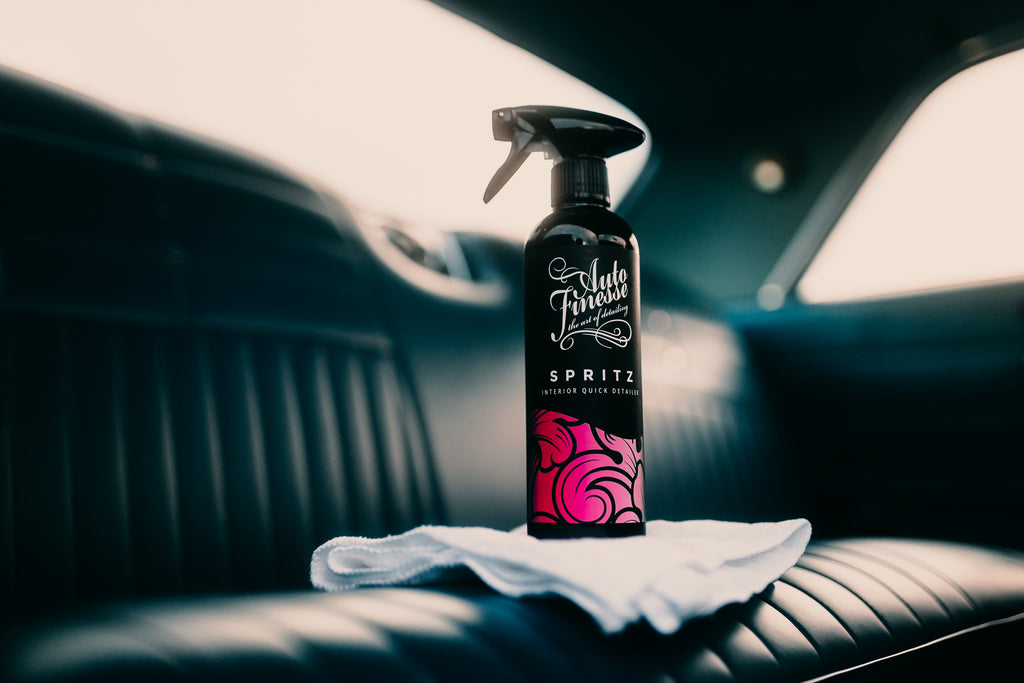Achieving A Concours Finish

In This Free Guide You Will:
- Master the art of elevating great paintwork to stunning, concours-worthy perfection.
- Uncover the essential techniques and key products to take any show car to the next level.
- Follow our step-by-step guide to make your car stand out at any event.

Benefits
- Using the right products correctly will always deliver the best results.
- These techniques can be applied to any car to enhance paintwork and overall appearance.
- Achieve professional-level detailing results and save thousands with just a few key products.
Your Paintwork May Be Impressive – But Is It Truly Show-Stopping?
Not all show cars are created equal. At the highest level, many extreme builds rarely see the open road, carefully preserved and transported from event to event. After all, if you’ve invested serious time and money into crafting a jaw-dropping machine, you’re unlikely to be commuting in it or taking it off-roading on the weekends.
But here’s the thing—no matter how immaculate a car may seem, almost every show car can be taken to the next level with expert detailing. Even at the world’s most prestigious events, it’s rare for a vehicle to be truly flawless under the critical eye of a professional detailer. While social media and magazine features might showcase perfection, the reality under bright indoor lighting often tells a different story.
Many of these cars also endure countless wipe-downs during events and quick cleans in less-than-ideal conditions. The good news? With just a few key products and techniques, you can elevate a great finish to an absolutely spectacular one. Whether you’re looking to perfect your paintwork for an entire show season or prepping for Ultimate Dubs this weekend, here’s how the pros make it happen…

The Outlaw...
The best way to demonstrate the process, as always, is to put it into practice—and we’ve got just the car for the job: the Porsche 356 Outlaw.
If you’re a regular on the UK show scene, you’ll likely recognize this stunning build. Over the past season, it has racked up an impressive collection of silverware, including multiple Best in Show awards and the coveted Auto Finesse Sponsor’s Choice Award at Ultimate Stance. Simply put, it’s already an exceptional car—as you can see from the photos.
Trophies aside, there’s no denying that this Porsche is meticulously maintained and seriously clean. But true concours-level detailing goes far beyond just keeping a car clean—it’s about refining every inch of paintwork and every surface to absolute perfection. So, let’s take this already award-winning build and push it even further…



The Wet Work
Since we're aiming for a full-on detail—complete with machine polishing to refine the paint to perfection—we'll be getting the car wet. While that may seem obvious, it's worth noting that some owners, particularly when maintaining their vehicle between events, opt for a "show wash" using a mixture of Finale Quick Detailer and water. This method works well on lightly soiled cars but isn't a substitute for a full detail when striving for a truly concours-level finish. If you're looking for an effective way to maintain your show car's finish indoors—whether in your garage or with the car stripped down for cleaning—you can check out our full guide: How to Perform an Indoor Wash and Show Car Detail.
Now, while you likely know every inch of your own show car, when detailing someone else’s vehicle, research and inspection are essential. This is always the first step in any professional detail—planning. In this case, we already know a few key details about the Porsche 356 Outlaw. It hasn’t been driven more than a couple of miles in good weather, and it's always cleaned after any outing. It has been transported in a closed trailer for longer journeys, so heavy contaminants like road salt, mud, or embedded metal particles— even on the wheels—are likely to be minimal, if present at all.
We also know that this isn't decades-old paint that has been excessively polished over the years. Instead, the car received a fresh respray before the last show season, meaning there’s ample clearcoat to work with for any necessary cutting and refinement.
Beyond the paintwork, other key factors will influence our approach. The wheels, interior materials, and engine bay all require careful consideration. For example, the car runs on air suspension, so we’ll need to raise it for optimal wheel and arch access. Additionally, the engine bay is trimmed with Alcantara, meaning a pressure washer isn’t an option for cleaning—though, in this case, it wouldn’t be necessary anyway.
Of course, we'll double-check every detail before diving in, but these factors will directly shape our detailing plan. Adapting your approach to suit the specific needs of each vehicle is crucial—and it's something that should be considered with every car you work on.

Cleaning The Wheels
As always, we start with the wheels—typically the dirtiest part of any vehicle. Cleaning them first prevents cross-contamination, avoiding the spread of harmful contaminants to other areas, especially the paintwork. While in this rare case there’s only a light layer of brake dust and grime, we still follow our usual routine, ensuring that any unseen particles are safely removed.
Detailers are creatures of habit, and that’s a good thing. Sticking to a structured process and adapting it to your routine helps guarantee the best results every time you detail. From the way you set up your buckets to the order in which you clean wheels (we always begin at the 12 o’clock position) and the path you follow during a contact wash, consistency ensures that no step is missed, and no area is overlooked.
Now, let’s talk about these wheels. These custom-made, three-piece forged rims are far from the standard painted or powder-coated alloys you’ll find on daily drivers. For show car owners, wheels are often a significant investment, coming in a variety of delicate finishes that require specific cleaning products and techniques. It’s not just about removing dirt—it’s about doing so safely, without causing damage to sensitive surfaces.
That’s why we developed Imperial Wheel Cleaner** and Revolution Wheel Soap—both safe for use on all types of finishes. These formulas work by combining surfactants, degreasers, and advanced cleaning agents to chemically break down contaminants, lifting them from the surface and encapsulating them in the solution. This allows grime, salt, and brake dust to be rinsed away effectively—without the risk of scratching.
The exact approach, including the brushes and mitts used, will always depend on the wheel design and level of contamination. Even with light grime like this, we still use both products to ensure a thorough clean. A quick spritz of Imperial over the entire wheel, followed by gentle agitation using Revolution Wheel Soap in our dedicated wheel bucket, is all that’s needed. The soap provides additional cleaning power and lubrication, allowing sharp contaminants—such as grit and brake dust—to slide off safely. Rather than scrubbing aggressively, the goal here is to refresh the cleaning agent on dirtier areas and maximize penetration, ensuring every inch of the wheel is properly treated. After that, it’s simply a case of rinsing and moving on to the next one.
For a complete breakdown of how to deep-clean, decontaminate, and protect different wheel types, check out our full guide: The Definitive Guide to Cleaning Alloy Wheels.

Pre-Wash
So, the car isn’t that dirty—does that mean we can skip straight to the contact wash? Absolutely not. One of the most common questions we get is: Should you pre-wash a relatively clean car? The answer is always yes. Even if a vehicle looks clean, there are often sharp particles, dust, and unseen contaminants that have settled on the surface or lodged in door jambs and panel gaps. If these aren’t removed before the contact wash, they can be dragged across the paint, causing swirl marks and other defects. Worse still, loose debris can be blown out of panel gaps later in the process, interfering with polishing and finishing. To avoid inflicting damage that requires extra correction, a proper pre-wash is essential.
The first step? A thorough rinse. This isn’t just about wetting the car—it’s about flushing out dirt and dust traps, including panel gaps, door jambs, wing mirrors, grilles, fuel flaps, and other hard-to-reach areas. This ensures that when we apply our cleaning agents, they’re tackling only the stubborn, stuck-on grime rather than loose contaminants that could have been removed with the pressure washer alone.
Next, we apply our Citrus Power Bug & Grime Remover across the entire car. This pre-cleaner is designed to break down, lift, and suspend grime away from the surface before it’s safely rinsed away. It’s powerful enough to handle heavy contamination but gentle enough for use on lighter soiling, making it a crucial step in preventing swirl marks. Even on a lightly soiled car, any remaining dirt can cause damage if poor wash techniques are used.
One major advantage of Citrus Power is that it’s specially formulated to be safe on existing protection layers. While this isn’t a concern for this particular job, it’s an invaluable feature for regular maintenance washes, ensuring that waxes, sealants, and ceramic coatings remain intact while delivering a deep and safe clean.

Snow-Foam
Another essential pre-wash step—one that won’t degrade wax or sealant layers—is Avalanche Snow Foam. Like Citrus Power, this citrus-based cleaning agent is designed to break down, lift, lubricate, and encapsulate grime (for a deeper dive into the science behind these cleaners, check out our article All Car Cleaning Products Explained). However, what sets Avalanche apart is its ability to foam up into a thick, clinging layer, allowing it to dwell on the surface for longer. This extended contact time helps break down even the most stubborn, stuck-on particles while also working its way into panel gaps, crevices, and other hard-to-reach areas to eliminate hidden contaminants.
If the previous pre-wash steps have effectively removed larger particles of grit and grime, Avalanche can also be agitated into intricate areas using a Detailing Brush. This step ensures that any lingering dirt is safely lifted away before moving on to the contact wash, reducing the risk of swirls or scratches during the next stage of the process.



The Contact Wash
Only once the pre-wash stages are complete is it safe to begin the contact wash with your Wash Mitt. As with any proper wash process, using the two-bucket method is essential—one bucket for your shampoo solution and another filled with clean water to rinse your mitt after every pass. This simple but crucial technique dramatically reduces the risk of introducing swirls, as it prevents dirty, contaminated solution from being reapplied to the vehicle. Opting for large 20-litre detailing buckets, like our Pro Bucket Combo, offers an added advantage: the increased water capacity, combined with grit guards, makes it nearly impossible for harmful particles to be recirculated back onto your mitt during the wash.
Choosing the Right Mitt, Shampoo & Technique
To maintain a swirl-free wash, your mitt, shampoo, and washing technique all play vital roles.
- The Wash Mitt: A high-quality mitt is designed to lift and trap sharp particles deep within the pile, keeping them away from your paintwork until they are safely rinsed out in the bucket. Here, we’re using our Plush Wash Mitt, which is specifically engineered to prevent contaminants from being dragged back across surfaces.
- The Shampoo: We use Lather Car Shampoo, which not only cleans but also acts as a lubricant, allowing grime to glide safely off the paintwork while ensuring your mitt moves effortlessly over the surface. It’s important to note that a wash mitt is not meant for scrubbing—instead, it ensures the shampoo solution reaches every part of the paintwork. Since Lather is a pure cleaner, it contains no waxes or fillers, meaning it won’t create a false finish or interfere with any further detailing steps.
- The Wash Technique: Always wash from the top down, starting with the cleanest areas first to avoid dragging dirt onto already-cleaned sections. Additionally, wash in straight lines rather than circular motions**—this further minimizes the risk of swirls while ensuring full, even coverage.
By following these essential steps, you’ll achieve a thorough, swirl-free clean while setting the foundation for a flawless, concours-level finish.

Drying Off
Moving on to the crucial drying stage. Many people underestimate just how important this step is. It's not only that the water used to clean your car is full of mineral impurities, which, if left to dry naturally, can leave deposits on your paintwork. The real challenge is removing these impurities—and the water—safely without causing defects. That’s why we rely on super-absorbent towels designed specifically for the task. Our Aqua Deluxe and Aqua Deluxe XL Drying Towels are incredibly soft and effective, drawing in the water and impurities together, keeping them away from the paintwork instead of just pushing the water around.
It’s essential to be thorough during this process. The last thing you want is water dripping from the recesses and interfering with your polish. Compounds and water don’t mix well—it can cause the product to clump and lubricate the abrasives, which reduces their effectiveness. Plus, it creates a mess!
This is one reason why professionals often use an air blower to clear out all the water from recesses before mopping up the rest with a towel. If you don’t have an air blower, just keep drying and take your time to ensure you catch any drips along the way.

Decon
Regular visitors to our site and socials may have noticed we haven't done the usual decontamination before drying the car, whereas normally, we'd be knee-deep in Iron Out and ObliTARate by now, right? So, is it really necessary for a car like this? The answer is a bit of both—yes and no.
Decontamination is a process where we remove embedded contaminants that washing alone can’t tackle. Typically, we'd carry out this multi-stage process before any paint correction. It's essential because any sharp particles left in the paint can get picked up by your polishing pad, and as you can imagine, a shard of metal or grit spinning around on your pad will definitely cause damage.
The first step involves using Iron Out Contaminant Remover to dissolve and rinse away any ferrous metal deposits that have embedded in the paint. These particles mostly come from brake dust or airborne debris from busy roads. We always emphasize that this step is non-negotiable—this process should be done before polishing because these tiny particles are easy to miss. However, in this rare case, the car hasn’t really been exposed to metal fallout, so we didn’t need to use it. That said, if you're ever in doubt, you can’t go wrong with Iron Out—it's safe for use on all painted surfaces.
Next, we have ObliTARate Tar & Glue Remover, which eliminates sticky residues. This powerful formula targets and melts away tar and other contaminants that could interfere with polishing. It’s important to note that ObliTARate is only necessary when there's sticky residue present, so if there’s none, like here, we can skip it.
Finally, the last step of decontamination involves using a Clay Bar with Glide Clay Lube to remove any bonded contaminants like tree sap, overspray, mineral deposits, and light iron or tar deposits. There wasn’t much to worry about on this car, but claying is always a crucial step in ensuring we don’t introduce any damage when polishing. We always clay the paintwork before starting any correction work. Any contaminants left behind could end up damaging the surface during polishing, especially when aiming for a flawless, concours-level finish. Plus, claying is an incredibly satisfying process—you can actually feel the difference as you work.

Masking Up
Often we're asked why we take the extra step of masking a car before polishing. The simple answer is that it helps prevent damage. Certain areas on any vehicle—like rubber window trims and weather strips—can suffer from the abrasive action of machine polishing pads. By covering these parts with detailer's masking tape, we avoid accidental compound transfer that might cause stubborn stains.
Similarly, features such as emblems, grilles, and door handles have hard edges that can catch on the pad—or even worse, the backing plate—resulting in damage to both the part (which can be nearly irreplaceable) and the polishing pad. Keep in mind that machine polishing pads spin at extremely high speeds, so any oversight can quickly lead to trouble. On this particular vehicle, we’re also dealing with a significant amount of extra brightwork that could be affected.
In short, any areas that don’t need polishing but are close to where you'll be working with your DPX or MPX Dual Action Polisher should be masked off or removed to avoid potential damage.

Paint Correcting
Every paint correction job depends on the severity of the defects present. The goal is to level the surface by removing material until you reach the bottom of the deepest flaw, effectively eliminating swirls or scratches to create a smooth, even finish. For a deeper dive into how a polish or compound works, check out our full article—The Basic Guide To Machine Polishing.
The key rule to remember here is simple: never over-polish. A common mistake in detailing is starting with a compound that's too aggressive, which then forces you into multiple rounds of polishing with progressively finer compounds. This often happens because the paint is softer than anticipated or the defects aren’t as severe as they appear. In any case, finding the right combination usually requires some testing.
During this testing phase, you begin with finer compounds and gradually move to coarser ones until you discover the first polish and pad combination that effectively cuts the defects. Once you’ve found this ideal mix, you stop and then reverse the process by working with progressively finer compounds to refine the finish to perfection.
In this instance, we're working on a show car with excellent paint in great condition and only a few minor swirls and light scratches. The job mainly involves refining the finish using a fine compound like Revitalise No:3 Refining Compound. However, in some areas where defects required a bit more correction, we stepped up to a medium compound (Revitalise No:2 Polishing Compound) before finishing with the finer compound.
Ultimately, whether you’re chasing a concours-level finish or just a flawless look, the objective is to make the clearcoat uniformly flat on a microscopic level. This uniformity ensures that light reflects evenly off the surface instead of scattering due to swirls and imperfections, which would otherwise highlight these flaws. A perfectly smooth surface appears deeper, glossier, and more refined—a result achieved only by using the finest abrasives. This is the essence of paint correction and the reason this Porsche's paintwork looks absolutely flawless.



Surface Prep
Since this is a show car, we're opting for a hard wax for our post-polish protection—a decision we'll explain further in the next section. For this job, we've chosen Illusion Show Wax because it’s loaded with synthetic polymers and gloss-enhancing oils that deliver a dripping, wet-look finish, plus it contains 48% T1 Brazilian carnauba for 2-3 months of durability. However, before applying any wax, it's crucial to prepare the surface so that the wax can form a strong, uninterrupted bond.
The ideal product for this step is Rejuvenate Paintwork Cleanser. This glaze-based abrasive is designed to prepare the surface and enhance the performance of our Signature Hard Waxes. While Rejuvenate is typically used to remove stubborn oxidation, oxidation wasn’t a concern on this car—any would have been eliminated during polishing. Instead, its powerful abrasives and deep cleaning solvents efficiently remove any remaining oily polishing residues, ensuring the surface is perfectly primed for ultimate bonding and a concours-level finish.

Protection Layers
Light refraction isn’t just important for your paint—it also plays a key role in your protection layers. While applying one or two layers of protection is crucial after polishing to guard against the elements, even a show car benefits from this step. Contaminants like dust can bond to an unprotected surface, potentially causing damage, especially when the car is frequently cleaned at events.
Beyond protection, waxes and coatings enhance the appearance of your paint by creating a smoother, more even surface. This allows light to pass through the protective layer, reflect off the paint, and return to your eyes with increased depth and gloss.
Imagine your finely polished paint as a miniature mountain range: even the smoothest surface has microscopic ridges and valleys. Although these imperfections are invisible to the naked eye, they can cause subtle variations in light refraction. A quality wax or coating fills in these gaps, ensuring a more uniform light reflection and resulting in a deeper, glossier finish. While these products do add a physical layer to the surface, their real magic lies in how they manipulate light to enhance the overall appearance.
So why choose a wax over a coating for this car? For a vehicle that isn’t driven regularly, the ultra-durable, glass-like protection of a coating isn’t necessary. More importantly, nothing matches the warm, rich glow that a wax finish provides on a show car. The natural impurities in waxes absorb and deflect light in unique ways, creating that signature warm glow—unlike clear coatings and sealants, which can sometimes appear overly shiny and sterile.

Applying The Wax
Finally, it’s time to apply our wax. Remember—a little goes a long way. A mere quarter-turn of a Waxmate XL in the pot is enough to cover an entire panel; using more just wastes wax when you buff it off. For the most even coat and optimal coverage, we apply multiple layers, waiting at least 4 hours between each.


When you reach this level of detailing, investing in a brand-new Micro Tweed Microfibre Buffing Towel is well worth it. Its unique microfibre weave tackles wax residue much like a wash mitt removes grime, safely lifting and trapping residues in the fibres to prevent wax clogging and reduce the risk of scratches.
Once the paintwork was completed, we moved on to the wheels—because wheels, especially on a car of this calibre, deserve protection and plenty of shine too! For this, we used Mint Rims Wheel Wax, a high-temperature synthetic wax blend designed specifically to repel even the harshest contaminants, including brake dust.

Finishing Touches
Your paintwork might be flawless, but what about the rest of the surfaces? For a true concours finish, every detail counts. Even the tiniest imperfection can distract the eye, but you can smooth these out with essential finishers like Crystal Glass Cleaner, Revive Trim Dressing, and Satin Tyre Crème. Once the major work on the paint is done, it's all about those finishing touches—after all, you wouldn’t want faded plastics, streaky windows, or dull, undressed tyres to detract from your hard work.


On this vintage show car, there was an abundance of brightwork to tackle—everything from the exhaust to various metal parts, both inside and out. That's where our Mercury Metal Polish comes into play. Packed with light abrasives and cleaning agents, it’s perfect for removing tarnish, oxidation, and ingrained contaminants, unveiling the original reflective finish and restoring the shine to any bare metal surfaces.




Finally, we add a small amount of our carnauba-infused Finale Quick Detailer to remove any lingering dust or fingerprints and boost the wax finish. Always finish with Finale.

And that’s how you take your show car to the next level, achieving a true concours-standard finish. The results on this Porsche speak for themselves. For more show-time detailing tips, including how to keep your car pristine throughout the event, check out our guide—How to Prepare Your Car for Any Show on the Go.











